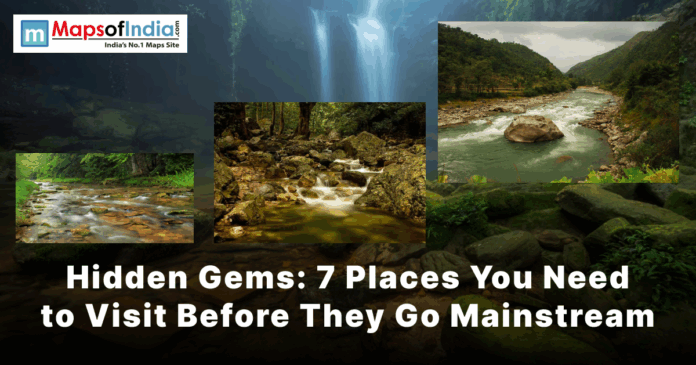Hidden gems offer untouched beauty and authentic experiences. In 2025, these spots remain off the radar. They provide solitude and cultural immersion. A 2025 Allied Market Research report says adventure tourism grows 17.4% annually. Travellers want to visit undiscovered destinations. According to the World Tourism Organization study, each year more than 1.5 billion international trips take place. Of those trips, only 5% go to remote areas. These places blend nature, history, and adventure. The best times to avoid crowds. What to see includes unique landmarks.
Faroe Islands, Denmark: Atlantic’s Rugged Archipelago
The Faroe Islands in Denmark are a Nordic secret. This group of 18 islands lies between Iceland and Norway. A 2025 StayVista report estimates 100,000 visitors yearly. That’s low compared to Iceland’s 2 million. Puffins nest on cliffs from May to August. Mulafossur Waterfall cascades into the ocean. Lake Sørvágsvatn appears to hover above sea level. Tórshavn, the capital, has colourful turf-roofed houses. A 2024 National Geographic article says it’s a birdwatcher’s paradise with 300 species. The best time is June to August for the midnight sun. Winters bring northern lights but storms. Fly to Vágar Airport from Copenhagen in 2 hours. Ferries connect islands. Hike Vestmanna Bird Cliffs for views. Pack waterproof gear for rain. Rent a car for flexibility. The Faroes offer dramatic landscapes and seclusion.
Azores, Portugal: Volcanic Atlantic Outposts
The Azores are a remote island group located in Portugal. This place has nine volcanic islands in the sea of Atlantic Ocean. A 2025 TravelTriangle report says 800,000 tourists in 2024. That’s 20% less than Madeira. São Miguel’s Sete Cidades crater lake stuns with blue waters. Pico Island’s volcano is Portugal’s highest at 2,351 meters. Furnas has hot springs and geysers. A 2024 Lonely Planet article notes 30 hiking trails. The best time is May to October for warm weather. Winters are mild but rainy. Fly to Ponta Delgada from Lisbon in 2 hours. Inter-island flights take 30 minutes. Stay at Furnas Boutique Hotel for Rs. 12,000 nightly. Visit Poça da Dona Beija for thermal baths. Pack hiking boots for lava trails. Rent a scooter for exploration. The Azores blend adventure and relaxation.
Bhutan: Himalayan Kingdom of Happiness
Bhutan remains a secluded haven in the Himalaya. This landlocked nation gives priority to the happiness of nations people. This nation has more than 100000 tourists visiting each year. High fees keep numbers low. Paro Taktsang, the Tiger’s Nest Monastery, clings to cliffs. Punakha Dzong is a fortress masterpiece. Thimphu blends tradition and modernity. A 2024 CN Traveller article notes 337 bird species. The best time is March to May or September to November for clear skies. Monsoons flood roads in summer. Fly to Paro Airport from Delhi in 2 hours. Entry needs $200 fee for each day. Hike to Taktsang for spiritual views. Pack modest clothes for monasteries. Bhutan offers serenity and sustainability.
Svalbard, Norway: Arctic Wilderness Adventure
Svalbard is Norway‘s northern outpost. This Arctic archipelago has polar bears outnumbering people. A 2025 Holidify report says 65,000 visitors yearly. Longyearbyen, the main town, has 2,500 residents. See ice caves and glaciers. Northern lights dance from September to March. A 2024 Lonely Planet article notes 60% of land is protected. The best time is June to August for the midnight sun. Winters are dark but aurora-rich. Fly to Longyearbyen from Oslo in 3 hours. No visas for most, but permits for activities. Stay at Svalbard Hotell for Rs. 15,000 nightly. Snowmobile to Barentsburg for Russian culture. Pack thermal suits for cold. Carry bear spray for safety.
Socotra, Yemen: Alien Landscape Island
Socotra Island is are isolated island which are located in Yemen. This island is in the Arabian Sea, and it has dragon blood trees. A 2025 TravPedia report says 5,000 tourists in 2024. UNESCO protects its biodiversity. Bottle trees and cucumber trees dot the land. Haghier Mountains rise 1,500 meters. A 2024 Down to Earth article notes 37% endemic plants. The best time is from October to April for mild weather. Summers on this island can hit 40°C. A visa is necessary to visit this place. During the visit, you can stay at eco-lodges for Rs. 4000 each night. Plan a hike to Dixsam Plateau to get great views. Pack sunscreen and water. Hire local guides for safety. Socotra’s unique flora feels otherworldly.
Raja Ampat Indonesia: Underwater Paradise
Raja Ampat is Indonesia‘s underwater haven. This archipelago has 1500 islands. This place has 30000 visitors each year. Coral reefs host 1,700 fish species. Manta rays and sharks swim freely. A 2024 Lonely Planet article notes 75% of the world’s coral species are here. The best time is from October to April for calm seas. Monsoons bring rain. Fly to Sorong, then boat to the islands. Permits cost $50. Stay at Raja Ampat Biodiversity for Rs. 10,000 nightly. Dive at Cape Kri for record fish counts. Pack reef-safe sunscreen. Use licensed operators. Raja Ampat’s biodiversity amazes underwater explorers.
Patagonia Chile and Argentina: Southern Wilderness
Patagonia, the southern wilderness, spans Chile and Argentina. This region has glaciers and peaks. Each year, this place receives nearly 200000 visitors. Torres del Paine National Park has granite towers. Perito Moreno Glacier calves dramatically. A 2024 CN Traveller article notes 5,000 km of trails. The best time is December to February for summer. Winters are harsh with snow. Fly to Punta Arenas, then bus to the parks. Visas are not needed for most. Stay at EcoCamps. Hike the W Circuit for views. Pack windproof jackets. Hire guides for safety. Patagonia’s vastness offers solitude and adventure.
Why These Places Are Hidden Gems
These destinations offer exclusivity to the visitors. The Faroe Islands receive more than 100000 visitors each year. The Azores see 800000. Bhutan charges a certain fee for visitors, limiting visitors number to 100000. Svalbard draws 65,000. Socotra has 5,000. Raja Ampat gets 30,000 divers. Patagonia hosts 200,000. The trend of offbeat tourism has grown by 12%. This provides an authentic experience to travellers. What to see includes the unique nature. Tips like permits ensure smooth trips. These gems remain unspoiled.
Conclusion
Hidden gems like the Faroe Islands offer solitude. The Azores’ volcanoes amaze. The beauty of nature in Bhutan is something to marvel at. Socotra’s trees astound. Raja Ampat’s reefs dazzle. Patagonia’s glaciers inspire. A 2025 Grand View Research report says tourism hits $1.8 trillion. Visit before mainstream crowds arrive. Plan for seasons and safety. These places deliver unforgettable adventures.





